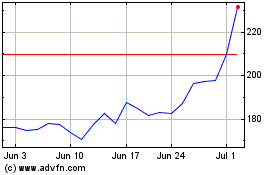By Russell Gold
Giant batteries charged by renewable energy are beginning to
nibble away at a large market: The power plants that generate extra
surges of electricity during peak hours.
Known as peakers, the natural-gas-fired plants are expensive to
run, and typically called into service only when demand rises and
regular supplies are insufficient. That makes them vulnerable to
disruption from lithium-ion batteries, which have fallen in price
in recent years, and are emerging as a competitive alternative for
providing extra jolts of electricity.
Numerous big batteries are under construction or consideration
in the U.S., especially in the Southwest, where some companies see
a shiny future for "solar plus storage" projects.
In Arizona, Tucson Electric Power is building a 100-megawatt
solar facility and a 30-megawatt battery array. The project, being
developed by NextEra Energy Inc., would allow Tucson Electric to
store inexpensive solar generation in the morning, when power
demand is low, and deploy it in the heat of the afternoon. The
company hasn't disclosed its costs.
Jim Robo, NextEra's chief executive, told investors late last
year that the batteries can provide power "for a lower cost than
the operating cost of traditional inefficient generation
resources."
A battery array three times the size of the Tucson project is
being developed in Long Beach, Calif. Fluence Energy LLC, a joint
venture of AES Corp. and Siemens AG, is building a battery that
could power 60,000 southern California homes for up to four hours.
It will be the largest lithium-ion battery in the world -- three
times larger than a battery built last year by Tesla Inc. in
Australia.
"It really is a substitution for building a new peaking power
plant," says John Zahurancik, chief operating officer of Fluence.
"Instead of living next to a smoke stack, you will live near what
looks like a big-box store and is filled with racks and rows of
batteries."
The new way of providing peak-time power poses a threat to
manufacturers of power turbines, such as Siemens and General
Electric Co., both of which announced large-scale layoffs in those
businesses last year.
Because large battery arrays remain costly, their use on power
grids currently remains limited to niche areas. But if batteries
prove their value and reliability, they could play a larger role on
the power grid in the future by storing more of the electricity
wind and solar farms intermittently generate for use when
needed.
Peaking plants usually run only a few hours a day to provide
extra power when demand is at its highest level. They typically run
on natural gas and burned about $1.1 billion of the fuel in 2016,
according to federal data.
The federal government estimates that a new gas-fired peaking
plant could generate electricity for about $87 for a megawatt hour,
including the cost of building the plant and buying fuel. By
comparison, Xcel Energy Inc.'s Colorado subsidiary recently ran an
open solicitation and received 87 bids for solar-plus-storage
projects at a median price of $36 per megawatt hour, one of the
lowest such bids to date.
"I could see in 10 to 15 years where you have 30% of what is
traditionally a peaker market served by storage," said Ben Fowke,
chief executive of Xcel Energy, a Minnesota-based utility.
Batteries have been used on power grids for several years, but
mainly to provide brief pulses of electricity to stabilize the
voltage and frequency, sometimes as short as a few seconds. On the
giant PJM Interconnection, which serves parts of 13 states from
Pennsylvania to Illinois, batteries provide about a quarter of such
regulation services.
The batteries now being proposed and built are much larger, and
meant to provide more sizable loads of electricity for four hours
or more, said Anissa Dehamna, an associate director at Navigant, a
power-consulting company.
"Peaker replacement is the biggest market they have in sight,"
said David Hart, a public-policy professor at George Mason
University in Virginia who recently wrote a report for the Energy
Department about grid batteries.
Overall, it still generally costs 35% more today to provide
extra power via a battery compared with a conventional peaker
plant, according to energy analysts at SSR LLC. But they estimate
that batteries will be less expensive by 2024. Batteries, they add,
are better suited to replace peaker plants in warmer areas than in
colder climates, where winter peaks can last for longer than four
hours.
Government directives are driving battery adoption in some
states. California has a mandate to add 1.3 gigawatts of storage by
2020, and both New York and Massachusetts are developing similar
programs. Last month, California ordered PG&E Corp. to seek out
bids for energy-storage systems instead of relying on three
existing gas plants, and concluded the move "could result in lower
overall ratepayer costs."
The American Petroleum Institute, a lobbying group that
represents natural-gas producers, applauds batteries but believes
they should compete on a level playing field. Storage projects
currently qualify for a 30% federal investment tax credit.
"It appears that battery technology is now ready to compete in
the market. This means the financial support provided by
governments intended to encourage the development and deployment of
the technology can be eliminated," an Institute spokesman said.
In Arizona, Corporation Commissioner Andy Tobin, a Republican,
recently proposed a three-gigawatt mandate by 2030. He argues that
investing in battery storage, instead of new gas plants, makes
business sense for the sun-rich state. "The writing is on the
wall," he said.
(END) Dow Jones Newswires
February 12, 2018 05:44 ET (10:44 GMT)
Copyright (c) 2018 Dow Jones & Company, Inc.
Tesla (NASDAQ:TSLA)
Historical Stock Chart
From Mar 2024 to Apr 2024

Tesla (NASDAQ:TSLA)
Historical Stock Chart
From Apr 2023 to Apr 2024
